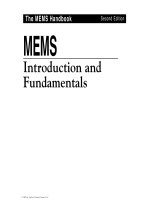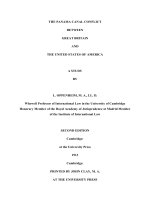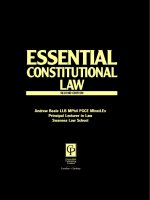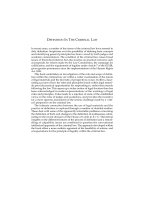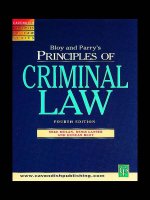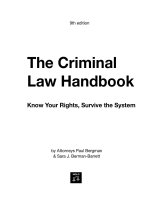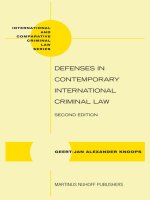FORENSIC EVIDENCE: SCIENCE AND THE CRIMINAL LAW SECOND EDITION pdf
Bạn đang xem bản rút gọn của tài liệu. Xem và tải ngay bản đầy đủ của tài liệu tại đây (2.67 MB, 534 trang )
FORENSIC
EVIDENCE:
SCIENCE AND THE
CRIMINAL LAW
SECOND EDITION
2858_C000.fm Page ii Monday, October 17, 2005 4:00 PM
A CRC title, part of the Taylor & Francis imprint, a member of the
Taylor & Francis Group, the academic division of T&F Informa plc.
FORENSIC
EVIDENCE:
SCIENCE AND THE
CRIMINAL LAW
Terrence F. Kiely
SECOND EDITION
Boca Raton London New York
Published in 2006 by
CRC Press
Taylor & Francis Group
6000 Broken Sound Parkway NW, Suite 300
Boca Raton, FL 33487-2742
© 2006 by Taylor & Francis Group, LLC
CRC Press is an imprint of Taylor & Francis Group
No claim to original U.S. Government works
Printed in the United States of America on acid-free paper
10987654321
International Standard Book Number-10: 0-8493-2858-6 (Hardcover)
International Standard Book Number-13: 978-0-8493-2858-9 (Hardcover)
Library of Congress Card Number 2005050625
This book contains information obtained from authentic and highly regarded sources. Reprinted material is
quoted with permission, and sources are indicated. A wide variety of references are listed. Reasonable efforts
have been made to publish reliable data and information, but the author and the publisher cannot assume
responsibility for the validity of all materials or for the consequences of their use.
No part of this book may be reprinted, reproduced, transmitted, or utilized in any form by any electronic,
mechanical, or other means, now known or hereafter invented, including photocopying, microfilming, and
recording, or in any information storage or retrieval system, without written permission from the publishers.
For permission to photocopy or use material electronically from this work, please access www.copyright.com
( or contact the Copyright Clearance Center, Inc. (CCC) 222 Rosewood Drive,
Danvers, MA 01923, 978-750-8400. CCC is a not-for-profit organization that provides licenses and registration
for a variety of users. For organizations that have been granted a photocopy license by the CCC, a separate
system of payment has been arranged.
Trademark Notice: Product or corporate names may be trademarks or registered trademarks, and are used only
for identification and explanation without intent to infringe.
Library of Congress Cataloging-in-Publication Data
Kiely, Terrence F.
Forensic evidence : science and the criminal law / Terrence F. Kiely 2nd ed.
p. cm.
Includes index.
ISBN 0-8493-2858-6
1. Evidence, Expert United States. 2. Forensic sciences United States. I. Title.
KF8961.K54 2005
345.73'067 dc22 2005050625
Visit the Taylor & Francis Web site at
and the CRC Press Web site at
Taylor & Francis Group
is the Academic Division of T&F Informa plc.
2858_Discl.fm Page 1 Tuesday, July 12, 2005 11:06 AM
v
Dedication
This book is dedicated to the loving memory of my mother, Elizabeth Wolfe,
and my step-father, John Wolfe.
vii
Preface
In investigations of every kind it is essential that a correct estimate
be made, of the kind and degree of assurance of which the subject
admits.
In the subjects of moral science, the want of appropriate words,
and the occasional application of the same word to denote differ-
ent things, have given occasion to much obscurity and confusion
both of idea and expression; of which a remarkable exemplifica-
tion is presented in the words probability and certainty.
William Wills: An Essay on the Principles
of Circumstantial Evidence (1838)
Forensic Evidence: Science and the Criminal Law (Second Edition), is
intended to serve as an introduction and guide to the appreciation and
understanding of the significant historic, contemporary, and future relation-
ship between the world of the forensic sciences and the criminal justice
system. This book is not intended to be a close study of forensic science, nor
was it ever conceived as becoming one. It is devoted to a study of the judicial
response to uses of forensic science in the investigation, prosecution, and
defense of a crime. The audience to which this study is directed are those
intimately or potentially involved in that relationship: police, forensic scien-
tists, prosecutors, defense lawyers, and professors and students of the criminal
law. It is meant to stand on its own but also to complement the growing
number of excellent treatises and studies in the forensic sciences proper, many
of which are published in the CRC Press series in the area of forensic sciences.
The book will focus on those cases questioning the legal acceptability
under a Frye or Daubert standard of the methodological basis of the forensic
science at issue. However, equally, if not more important, will be the discus-
sions of the numerous cases where the courts, assuming the acceptability of
the underlying methodology, have scrutinized and accepted or rejected a wide
variety of investigative uses of the science under discussion, offered as proof
viii Forensic Evidence: Science and the Criminal Law, Second Edition
of one or more material facts in a criminal prosecution. This latter area of
study is of equal, if not more central importance in understanding the place
of forensic science in the criminal justice system of the 21st century.
It is time for another close look at both the body of claims and actual
expert opinions supplied to the criminal justice system as we enter the first
decade of the new century. The totally justified attention given rapid DNA
developments should not overshadow the ongoing judicial acceptance and
use of the more traditional body of forensic sciences such as hair, fiber,
ballistics, or fingerprints, most of which have never been fully challenged.
The contributions of forensic science to the criminal justice system have been,
and remain, significant.
This book is divided into 12 chapters, most of which, with the exceptions
of Chapters 1, Science, Forensic Science, and Evidence and Chapter 2, Science
and the Criminal Law, address the legal profile of a specific forensic science.
Chapter 1, Science, Forensic Science, and Evidence, briefly analyses the
historical and contemporary context in which legal arguments directed to
the adequacy of the findings of forensic science are conducted. This is a
necessary precursor to the more criminally focused discussion that constitutes
the bulk of this volume. The framework of the Frye and Daubert standards
for the introduction of scientific opinion will be discussed here as well as the
significant differences that exist when the legal challenge comes in a civil as
opposed to a criminal law forum.
Chapter 2, Science and the Criminal Law provides an overview of the
entire subject of the uses of forensic sciences in the investigation, prosecution,
and defense of criminal cases in American courts. Central topics addressed
there are the historical and contemporary relationship between forensic sci-
ence and proof of crime, the fundamentals of the application of forensic
science disciplines to the investigation and prosecution of a criminal case,
the function of probabilistic to that process and an extended discussion of
the legal aspects of the modern crime scene. A brief listing of those chapters
follows:
Chapter 3, Hair Analysis, will discuss the court’s response to both class
and individual opinions as respects attempts to connect one or more hairs
found at a crime scene to an individual suspect. This controversial subject
will set the analytical framework for the discussions to follow on a wide range
of forensic science applications.
Chapter 4, Fiber Analysis, will discuss the identification and use of a
wide variety of fiber materials from crime scenes and the processes used to
link any such materials to a suspect.
Chapter 5, Ballistics and Toolmarks, will address the subjects of firearms
and projectile identification, the matching of bullets to a weapon, gunshot
Preface ix
residue and toolmark identification and attempts to match crime scene stri-
ations to a tool associated with a suspect.
Chapter 6, Soil, Glass, and Paint, discusses the nature of soil and glass
shard particle identification and the attempt to connect such materials with
an individual suspect.
Chapter 7, Footwear and Tire Impressions, addresses the identification,
photographing, and or casting of footwear and tire impressions found at a
crime scene to those associated with a suspect.
Chapter 8, Fingerprints, discusses the subject of fingerprint identifica-
tion procedures and the recent Automated Fingerprint Identification System
(AFIS).
Chapter 9, Blood Spatter Analysis, analyses cases involving the subject
of presumptive testing for blood products as well as the subject of blood stain
pattern analysis and its importance in many key aspects of crime scene
reconstruction efforts.
Chapter 10, DNA Analysis, will analyze the court’s scientific conditions
for the acceptance of identification testimony arising from RFLP, PCR, STR
DNA and mitochondrial (MtDNA) analyses, in addition to the small but
growing number of cases and articles addressing nonhuman DNA testing, in
particular, dog, cat, and plant DNA testimony.
Chapter 11, Forensic Anthropology and Entomology will briefly exam-
ine those decisions that utilize the methodologies and findings of these fields
as aides to the investigation and identification of human remains and pro-
viding time of death estimates.
Chapter 12, Epilogue, will provide a brief summary note on the subjects
not covered in this book and the major points sought to be made in the
entire work.
xi
The Author
Terrence F. Kiely is a professor of law and the director of the DePaul Uni-
versity College of Law’s Center for Law and Science.
Professor Kiely graduated from Loyola University in Chicago (B.S.,
humanities) in 1964, DePaul University College of Law (Juris Doctor) in 1967
and also received an LL.M (foreign and comparative law) from New York
University School of Law in 1970. Professor Kiely is an expert in the area of
the interaction between science and the civil and criminal law. He is the
author of five previous books:
Preparing Products Liability Cases (John Wiley & Sons, 1987)
Using Litigation Databases (John Wiley & Sons, 1989)
Modern Tort Litigation (John Wiley & Sons, 1990)
Forensic Evidence: Science and the Criminal Law (CRC Press, 2001)
Science and Litigation: Products Liability in Theory and Practice (CRC
Press, 2002)
Professor Kiely has been a full time member of the DePaul University
College of Law faculty since 1972. He teaches in the areas of torts, products
liability, criminal law, evidence and forensic evidence. During the academic
years 1995–1996 he was the Robert A. Clifford Professor of Tort Law and
Public Policy. His work with the Center for Law and Science involves the
maintenance of a comprehensive law and science Web site and organizing
and participating in forensic science and evidence seminars at the College of
Law.
xiii
Contents
1. Science and the Criminal Law 1
I. Science and the Legal Process 1
II. Forensic Science Questions 2
III. Forensic Science and Circumstantial Evidence 6
IV. Forensic Science, Forensic Evidence, and the Modern Crime Scene 7
V. Scientific Foundations and the Courts 8
VI. Science and the Courts 10
VII. Frye v. United States 11
VIII. Daubert v. Merrell Dow Pharmaceuticals 12
IX. General Electric v. Joiner 16
X. Kumho Tire v. Carmichael 17
XI. People v. Sutherland: A Case Study 19
The Sutherland Case Facts 20
The Prosecution’s Forensic Evidence: The Tire Tracks 21
The Prosecution’s Forensic Evidence: The Hair Evidence 21
The Prosecution’s Forensic Evidence: The Fiber Evidence 22
The Court’s Analysis: The Hairs and Fibers 23
The Sutherland Case: The Court’s Analyses 25
Sutherland II Case 25
Sutherland Conclusion 28
Appendix: Daubert Progeny 28
Endnotes 33
2. Science, Forensic Science, and Evidence 41
I. Introduction 41
II. Forensic Science and Evidence 44
III. Forensic Evidence and History 48
IV. Forensic Evidence and the Crime Scene 50
V. Forensic Evidence Basics 52
VI. Forensic Evidence and Circumstantial Evidence 55
VII. Forensic Science, Probability, and the Law 57
VIII. Forensic Science and the Courts: Frye, Daubert, and Beyond 61
xiv Forensic Evidence: Science and the Criminal Law, Second Edition
IX. Basic Questions Related to Forensic Science and Forensic Evidence 64
Class and Individual Characteristics 65
X. Laboratory Matches and Courtroom Rules of Evidence 66
XI. Conclusion 69
Endnotes 70
3. Hair Analyses 79
I. Introduction 79
II. Hair Analysis Basics 81
III. Discovery Issues 83
IV. Matching Statements 84
V. Recent Case Discussions: Qualifications 87
Prosecutorial Characterizations of Hair Testimony 95
VI. Mitochondrial DNA [mtDNA] and Hair Analysis 106
VII. The Evidence on the Petition for New Trial 119
VIII. Conclusion 121
Endnotes 122
4. Fiber Analysis 135
I. Introduction 135
II. Fiber Evidence in the Courtroom 137
III. Discovery 140
IV. Wayne Williams Case 143
V. Additional Fiber Cases 153
VI. Fiber Persistence 158
VII. Conclusion 166
Endnotes 167
5. Ballistics and Tool Marks 177
I. Introduction 177
II. Ballistics and Forensic Evidence 180
III. Ballistics Experts: Qualifications 184
IV. Weapon Identification 185
V. Computer-Generated Animation of Crime Scenes 193
VI. Bullet Ricochet 194
VII. Angle of Shoot 194
VIII. Bullet Matching 199
IX. Bullet Lead Matching — ICP Methodology 208
X. Incompetence of Counsel 212
XI. Gunshot Residue 214
XII. Suicide vs. Homicide 221
XIII. Tool Marks 222
Contents xv
XIV. Conclusion 227
Endnotes 228
6. Soil, Glass, and Paint 241
I. Glass, Paint, and Soil in the Courtroom 241
II. Glass Analysis 241
III. Glass in the Courtroom 244
IV. Paint Analysis 257
V. Soil Analysis 263
VI. Soil and Cadaver Dogs 265
VII. Soil and Forensic Archeology 270
VII. Conclusion 272
Endnotes 272
7. Footprints, Tire Impressions, and Bite Marks 281
I. Introduction 281
II. Foot Impressions in the Courtroom 282
III. Footwear Cases 293
IV. Expert vs. Nonexpert Opinion 293
V. Barefoot Impression Evidence 296
Footwear Impression for Indigent Defendant 301
Footwear-Impression Testimony 304
VI. Footwear Trails 311
VII. Indirect Proof of Footwear Impression 312
VIII. Tire Impressions 314
IX. Bite-Mark Impressions 317
X. Bite Marks: Enhanced Imaging and Overlays 321
Endnotes 327
8. Fingerprints 339
I. Introduction 339
II. International Working Groups 339
III. Fingerprints: American Experience 342
IV. Fingerprint Questions 347
V. Fingerprint Foundations 349
VI. Fingerprints: Daubert Challenges 350
VII. Fingerprints: Digital Print Machines 354
VIII. Fingerprints: Discovery of Automated Fingerprint System
Printouts 355
IX. Fingerprints: Absence of Fingerprints 356
X. Time and Place Requirements 357
XI. Lip Marks 365
xvi Forensic Evidence: Science and the Criminal Law, Second Edition
XII. Ear Impressions 368
Endnotes 379
9. Blood-Spatter Analysis 389
I. Introduction 389
II. Blood Spatter: Presumptive Tests for Blood 391
III. Blood Spatter in the Courtroom 397
IV. Blood Spatter: Expert Qualifications 398
V. Blood Spatter: Crime Scene Dynamics 405
Endnotes 418
10. DNA Analysis 425
I. Introduction 425
II. DNA Research Resources 427
III. DNA: International Standards 428
IV. DNA: Questions for Lawyers 429
V. DNA Methodologies: RFLP 431
VI. PCR DNA Methodologies 436
VII. STR DNA Methodologies 438
Project Summary 440
VIII. DNA Mixture Cases 441
IX. Mitochondrial DNA: MtDNA 443
X. Nonhuman DNA 450
XI. DNA Related Cases: Post-Conviction Testing and Mandatory
Submission of DNA 451
XII. Post-Conviction DNA Testing 451
XIII. DNA Samples 454
XIV. John Doe DNA Warrants 459
XV. The Future of DNA Testing 461
Endnotes 462
11. Forensic Anthropology and Entomology 477
I. Introduction 477
II. Forensic Anthropology 478
III. Forensic Anthropology Cases 479
IV. Racial or Ethnic Identification 485
V. Individual Identifications 486
VI. Forensic Anthropology: Photography 486
VII. Cultural Anthropology 489
VIII. Forensic Entomology 492
IX. Entomology Cases 493
X. Conclusion 498
Contents xvii
Endnotes 498
12. Epilogue 505
Index 507
1
1
Science and the
Criminal Law
We have also houses of deceits of the senses, where we represent
all manner of feats of juggling, false apparitions, impostures and
illusions, and their fallacies. And surely you will easily believe that
we, that have so many things truly natural which induce admira-
tion, could in a world of particulars deceive the senses if we would
disguise those things, and labor to make them more miraculous.
But we do hate all impostures and lies, insomuch as we have
severely forbidden it to all our fellows, under pain of ignominy
and fines, that they do not show any natural work or thing adorned
or swelling, but only pure as it is, and without all affectation of
strangeness.
Francis Bacon: The New Atlantis (1626)
I. Science and the Legal Process
The term science in the discussions that follow has little or no connection
to the use and understanding of that term as it is uniformly thought of by
the international scientific community. John Horgan, former editor of Sci-
entific American, in his excellent book The End of Science: Facing the Limits
of Knowledge in the Twilight of the Scientific Age,
1
sought out the world’s
leading philosophers of science — theoretical physicists, evolutionary biol-
ogists, mathematicians, astronomers, and chaos theorists — to get their
perspectives on whether “science” was at a close, with nothing significant left
to be discovered. This book is a superb survey of modern scientific thinking
across a very wide variety of fields. The contemporary legal question regarding
2 Forensic Evidence: Science and the Criminal Law, Second Edition
the adequacy of a scientific methodology to support an expert opinion is
light years away from the type of scientific inquiry discussed by the scholars
Horgan interviewed. Horgan notes the criticism by Nobel prize-winning
chemist Professor Stanley Miller of scientific papers culled from other
published papers where no hard-won finding has resulted from extensive
laboratory work. Professor Miller referred to such works as “paper chemistry.”
In the hard-fought, science-based civil cases, such as the breast-implant
actions or the polychlorinated biphenyl (PCB) and cancer litigation, we can
borrow the idea and refer to the use of previously published articles, by
extrapolation in such cases, to claim or deny causation as “paper science,” a
charge that may be made in part only about forensic science-based testimony
in criminal cases.
2
The attempts to formulate an overarching answer to the question of
“What is science?” in the world of scientific endeavor and the American legal
system are clearly distinct in overall goals, methodology, and practical appli-
cations. When the question is restricted to the area of law, the use of science
in civil tort cases and in criminal prosecutions is also based on significantly
different goals, methods, and practical effects. The issues of whether long-
term exposure to phencyclidine (PCP) can cause cancer in a products liability
lawsuit are quite different from the forensic issue of whether hair or fiber
expert testimony can be used to link a defendant to a crime scene in a
homicide prosecution. It is also important to understand the differences
between civil and criminal cases with respect to the performance of labora-
tory work pursued to answer key factual issues in the cases. Forensic scientists
in white lab coats are routinely involved in criminal prosecutions. Their work
is used to shed light on the physical dynamics that created the crime scene,
to add significant information linking a defendant to a crime scene, and to
move toward the identification of the perpetrator. Forensic scientists are
rarely involved in answering the essential scientific causation issues at the
center of modern products liability litigation.
II. Forensic Science Questions
Examining a set of rhetorical questions that revolve around our core inquiry
about the nature and value of forensic science can help to clarify the discus-
sions that follow.
• What facts or assumptions or surmises can be obtained from the
examination of one or more physical items gathered at a crime scene?
• What is the likely basis for such assumptions or projections, or guesses?
Science and the Criminal Law 3
• What value can be assigned to any factual estimation in a criminal
justice system where life and liberty and justice to a victim all play a
part?
• What is the meaning of statements that report one or more fibers or
hairs or footprints, are or are not consistent with, or not dissimilar
or substantially similar to, another fiber, hair, or footprint?
• What is the basis for such statements and what value can be allocated
to them if one set of exemplars was taken from a crime scene and the
other exemplars belong to a suspected perpetrator?
• What are the implications of such statements in the context of long-
held requirements that the elements of a crime must be proven beyond
a reasonable doubt? How does circumstantial evidence fit into pros-
ecutorial efforts designed to meet such a high bar of proof in a case
partially supported by hair or fiber evidence?
• How dependent is the power of forensic evidence on the traditional
observation by eyewitnesses?
• How much of forensic analysis and comparison testimony have to do
with scientific theory or recognized scientific methodology?
• What science, if any, has been traditionally associated with hair, fiber,
paint, or glass analysis; and how has that science changed as we enter
the 21st century?
• Is forensic analysis, aside from microscopy, scientific because of the
theoretical underpinnings of the discipline, or because of its use of
microscopy and other processes that aid its essentially observational
nature?
• What is the difference if the bulk of the forensic science analyses are
simply a combination of experience and modern microscopy? What
else, from a forensic scientist standpoint, can be said about fiber, hair,
footprints, fingerprints, or ballistics and their examinations and the
factual assumptions that result? Can more be found to give such
disciplines as great or greater credibility than fingerprint impression,
ballistics, tool marks, or deoxyribonucleic acid (DNA)?
The repetition of these recurring questions across the range of the forensic
sciences discussed in this book indicates the great similarity of trace-evidence
analysis, in both a class characteristic and especially in individualistic state-
ments, that seeks to link a particular suspect to a crime scene. In hair analysis;
footwear and tire impressions; glass, paint, and soil analyses; bite-mark
impressions, and most other, forensic science settings, we seek to discover
what general nonsuspect-related categories of information can be gleaned
from the analysis of a datum, for example, fiber obtained at a crime scene.
4 Forensic Evidence: Science and the Criminal Law, Second Edition
These class statements begin the sketch of the person or persons who
were present and are essential investigative links in the chain of circumstantial
evidence pointing toward a particular suspect. The success of such efforts,
of course, is directly related to the integrity of the crime-scene preservation.
The sad results in the recent Jon Benet Ramsey murder investigation testify
to that simple fact.
When speaking of law and science matters, there are two distinct areas
of legal practice involved. On the civil side, science-related issues are typically
involved in the area of product liability and its subset of chemical-based
injuries, often referred to as “toxic torts.” A wide range of business-related
legal issues may involve scientific matters, from contracts, to patent infringe-
ment, to antitrust, and so on. On the criminal-law side, the science-based
issues cover considerable ground, ranging from proof offerings in the areas
of hair and fiber analyses; soil, glass, and paint identification; and a host of
facts related to forensic pathology, toxicology, blood products, as well as the
area of ballistics and tool marks. In these kinds of criminal cases, some science
is accomplished to generate material facts, such as DNA identifications or
bullet or shell-casing matching, in the case at hand. This use of science is
different from civil, product-liability-type cases that are centered in issues of
causation, where not only no science is performed for the immediate case,
but where published scientific articles, usually not precisely descriptive of the
science at issue, are used through extrapolation analyses.
3
Forensic scientists “in white lab coats” are routinely involved in forensic
evidence-focused criminal prosecutions. Their work is used to shed light on
the physical dynamics that created the crime scene and to add significant
linking information as to the identity of the perpetrator. They are rarely
involved in answering the dispositive “scientific”-causation issues at the cen-
ter of modern product-liability litigation, such as “Does migrating silicone
from a ruptured breast implant cause autoimmune system damage?” These
types of issues are the focus of recent and ongoing United States Supreme Court
decisions that seek to finalize a “one-size-fits-all” definition of “science.”
4
Forensic evidence involves the efficacy of information that has been
scientifically generated for a particular case, the validity of which is grounded
in past experiences in similar cases as evidenced in the forensic literature.
Forensic evidence is a much more-real scientific application to the case at hand.
Tort cases, on the other hand, present a radically different situation. True
“science” questions are rarely central issues even in the most complex tort
products-liability cases. A clear cause-in-fact or causal-relation problem —
seldom the central issue in these cases — the questions revolve almost exclu-
sively around the issue of “science as business.” Most product liability cases
do not deal with “science” understood in the sense discussed in the world of
international science, at least not in any sense of the term as research scientists
Science and the Criminal Law 5
understand it. More often the focus is on one of the ways a manufacturing
corporation, utilizing complex but practical science to develop and market
products, designs it, or often publishes communications with regard to the
risks customers are exposed to by using such products.
5
The historical hallmark of crime-scene investigation has always included
close observation, well-paid attention, and the application of common sense
and logic to solving the crime being observed. These characteristic actions
were associated with crime scenes well before the current preoccupation of
the courts and legal scholars with the precise relationship of law and science,
especially in areas of tort causation in the civil law and the forensic sciences
in the criminal law. The law brings little to the table with respect to developing
acceptable scientific methodologies, theories, and opinions. What it has pur-
sued, especially at the very end of 20th century, is to craft legal doctrine
designed to ensure that proffered scientific explanations and opinions com-
port with the most credible scientific thinking about methods and conclusions
based on such, in instances where expert opinion is offered in a civil or
criminal case.
Recourse has always been to the scientific community involved for guid-
ance. This guidance was viewed, however reluctantly, as an inevitable neces-
sity in some form, from the earliest days of the common law. In Spencer
Cowper’s Trial,
6
held in England in 1699, the ongoing skirmish between
courts and expert witnesses can be seen in the following exchange:
Dr. Crell: “Now, my lord, I will give you the opinion of several ancient
authors.”
Baron Hatsell: “Pray, doctor, tell us your own observations.”
Dr. Crell: “My lord, it must be reading, as well as a man’s own experience,
that will make anyone a physician, for without the reading of books of that art,
the art itself cannot be attained to. Besides, my lord, I conceive that in such a
difficult case as this, we ought to have a great deference for the reports and
opinions of learned men. Neither do I see why I should not quote the fathers of
my profession in this case as well as you gentlemen of the long robe quote Coke
upon Littleton in others.”
Baron Hatsell’s understandable reluctance to allow “testimony” of
authors not subject to cross-examination notwithstanding, the common law’s
dependence on the world of science and its experts remains.
Modern criminal courts, post-Daubert, are feeling the increasing need
to comply with defense demands to delve into the scientific bases of the whole
body of the forensic sciences, not the least of which are the trace evidence
staples of hair, fiber, soil, and finger and footwear impressions. What is coming
to the surface in these recent challenges are basic observational disciplines
aided by modern microscopy, without the existence of the minimal type of
comparative statistical databases available in more science-based disciplines
6 Forensic Evidence: Science and the Criminal Law, Second Edition
such as DNA typing and population predictability. The primarily observa-
tional base of a significant amount of forensic sciences’ contribution to the
criminal law may seem alarming, but close observation has always been the
case. This reality does not detract from the increasingly modern scientific
environment in which so much forensic work is achieved and its factual
offerings input into modern criminal trials.
7
III. Forensic Science and Circumstantial Evidence
Circumstantial evidence, specifically, the subjects — traditional modes of
observation and examining forensic practices and probability analyses — are
separate but intimately related aspects of historical and contemporary
attempts at truth seeking and truth finding in the criminal trial process.
Contemporary forensic-evidence conferences and the forensic literature
exhibit considerable enthusiasm for the power and potential of twenty-first-
century scientific advances for the investigation and solution of crimes, such
as DNA research and developments in laser-based technology. It is often
forgotten or overlooked, however, that the greater number of the traditionally
employed forensic sciences are, in effect, based on and centered in close
observation, aided by modern microscopy, and do not employ any additional
statistics-based projections as to the potential accuracy of the laboratory
“match.”
8
The term forensic is a very old word, always cast in terms of the
presentation of arguments in public forums.
9
In the face of ongoing criticism
that forensic or rhetorical arguments merely taught methods for embellishing
the truth, the rejoinder, from Plato’s day, has, on the contrary, been that
forensic argument is designed to “make the truth sound like the truth.”
10
An examination of American criminal cases from the earliest days of the
republic reveals several interesting observations about expert assistance in
establishing material facts in a prosecution for crime. Initially, it is of value
to note just how few such cases there are that address the issue in any signif-
icant way. Additionally, it is clear — as in the numerous science-based patent
cases — that courts were generally willing to listen, even gratefully, to qual-
ified experts, but given the basic observational and logical foundation for
forensic-based testimony, were generally much more skeptical and, at times,
demanding.
The beginnings of the legal response to information, based on studied
observation, logic, and common sense, are to be found in the late 18th
century and the second half of the 19th century. The real history of forensic
evidence and the criminal law does not begin with the increasingly impressive
applications of science since the 1920s and 1930s. Until that modern period,
